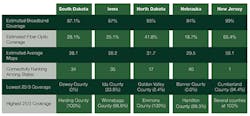South Dakota Paints a Bad Picture of Growing Urban-Rural Wireless Digital Divide —
A new study of users of rural wireless Internet suggests investment in new mobile technology is pivotal for economic development and quality of life in non-urban regions of the US. Failing to address this growing urban-rural digital divide could cause less populated regions to fall further behind cities, the study indicates.
Researchers from the University of South Dakota and Virginia’s Old Dominion University interviewed and surveyed rural South Dakota residents in the second half of 2018 to get their perception of the coverage, capacity, and speed, of Internet access.
The researchers were asked by telecommunications company T-Mobile to examine how uneven access to the Internet in different parts of the state affects economic opportunity.
Researchers from Old Dominion’s Social Science Research Center interviewed South Dakota residents in the rural communities of Springfield, Elk Point, Tyndall, Tabor, and Wakonda. Students at the University of South Dakota were also interviewed, and a web-based survey given to other residents of the state, to paint a detailed picture of rural Internet access and reliability.
The challenge is that South Dakota’s economy has outpaced national economic growth in the past 20 years. That economy has also diversified over the past few decades, shifting toward a service-oriented model that requires consistent access to the Internet.
However, many residents who were interviewed describe rural Internet services in negative terms. They suggest they are making the best of their technological situation, while at the same time noting that their rural networks have insufficient coverage, capacity, and speed, for basic health and safety, let alone quality of life.
As one respondent noted to researchers: "If the Taliban can upload videos in Afghanistan, how can I not get Netflix to play in America?"
Even robust economic growth in South Dakota has not prevented an outmigration of citizens from rural areas, a trend that is likely to accelerate as the urban-rural disparity deepens.
InvisiLight® Solution for Deploying Fiber
April 2, 2022Go to Market Faster. Speed up Network Deployment
April 2, 2022Episode 10: Fiber Optic Closure Specs Explained…
April 1, 2022Food for Thought from Our 2022 ICT Visionaries
April 1, 2022The Changing Landscape of Internet Access
Without any form of access to high-quality broadband service, many rural cities and towns are at a competitive disadvantage given the importance of the Internet, and, more specifically, the increasing importance of mobile services. If these rural localities are poorly served by existing fixed and mobile networks, the advent of 5G networks provides a generational opportunity for these communities to leapfrog existing fixed and mobile voice and data technology.
Perception is often reality, and mobile coverage, capacity, and speed, in South Dakota will likely influence economic and social development in the coming decade. The use of Internet-connected devices is now a feature of everyday life.
In general, rural areas are more likely to have lower rates of broadband coverage than urban areas, given that the unit costs of broadband investments are negatively correlated with population density. The last mile of the telecommunications network is the crux of this problem. Fixed broadband typically requires the installation of a line to each customer.
If a node or pole is not near the customer’s location, the installation costs can increase significantly. Mobile networks, on the other hand, require the installation of towers. Given the greater number of permanent and transient customers served by a tower, the unit costs of mobile networks should be less, on average, than fixed networks in rural areas.
We argue that the FCC’s efforts to expand broadband access, including, for example, its investment of up to $453 million in annual universal service support for a period of 10 years through the FCC’s Mobility Fund Phase II is, in part, acknowledgement of the increasing role of mobile broadband in closing the urban-rural digital divide.
To place the challenge in context, we provide estimates of fixed broadband coverage for South Dakota and selected neighboring states in 2018. (See Table 1 below. It was retrieved from https://broadbandnow.com/South-Dakota on December 18, 2018.) We also provide New Jersey, which is ranked first in terms of broadband connectivity, as a comparison state. While no estimates are perfect, we argue that any biases should be common among all the states, that is, if the data overestimates coverage, the data should be biased upward for each of the states. Thus, we concentrate less on the absolute magnitude of the characteristics and more on the relative differences between the measures of coverage.
Table 1. Internet Access Characteristics, 2018. Source: Estimates Reese, N. (2018). Internet service providers: availability and coverage. 25/3 coverage is an estimate of the percent of the population that has accesses to 25 Mbps download and 3 Mbps upload speed.
A common characteristic of South Dakota and its selected neighbors is the relatively low population density outside of urban areas (United States Census Bureau, 2017). Higher-ranking states in terms of connectivity tend to be more geographically concentrated and thus offer lower unit-costs per broadband customer. Second, even within urban areas in South Dakota and its neighboring states, access to speeds higher than 25 Mbps down and 3 Mbps up is relatively limited compared with Mid-Atlantic and Pacific urban areas. For example, while 18.8% of South Dakotans lack access to 100 Mbps down and 10 Mbps up broadband speeds, 87.6% do not have access to 250 Mbps down and 25 Mbps up speeds (Federal Communications Commission, 2018). Being in an urban area in a rural state may not afford the same access to the Internet as a rural area in a relatively urban state.
A recent estimate by the South Dakota Telecommunications Association (SDTA) highlights the challenge of fixed broadband investments in less populated areas of the state. The estimated average per-mile cost of installing backbone fiber was $16,000 for rural areas of South Dakota but was $60,000 per mile in the metropolitan Sioux Falls area. However, while the SDTA estimated the population density of the Sioux Falls metropolitan area was 2,490 residents per square mile, it estimated that the population density of its rural customers was only 4.5 residents per square mile. The low population density of rural areas meant that the average cost per resident of installing backbone fiber was $3,571 per resident, compared to $25.54 in the Sioux Falls metro area (South Dakota Telecommunications Association, 2018).
Like this Article?
Subscribe to ISE magazine and start receiving your FREE monthly copy today!
Final Thoughts
Internet access has changed over the last 2 decades from a luxury to a necessity. Not only does the evidence suggest that improved Internet access and speed is positively associated with employment, it corroborates the argument that Internet access improves the acquisition of human capital, agricultural productivity, and a host of other positive outcomes. The important policy question now is whether South Dakota, and by extension, other rural states, can access these outcomes. Investments in mobile coverage, capacity, and speed, are likely to be a fundamental component of any future growth strategy.
For South Dakota, the relatively low population density in rural areas means that public services may be infrequent or require significant travel. Improving mobile coverage and speeds offers local and state governments the opportunity to provide more services remotely. Online education is difficult, farmers cannot reliably utilize and take advantage of market data, and remote medicine is fraught with peril without high-quality Internet connectivity. The challenge, however, is a persistent urban-rural divide in access to the Internet. This divide not only manifests itself in fixed broadband networks, but, more importantly, in mobile access, capacity, and speed. The transition to 5G networks presents a unique opportunity to bridge the digital divide and improve the quality of life of rural residents.
We argue that decision-makers should not satisfice with regards to the quality of mobile broadband. Internet services and applications evolve quickly with the advent of new technology. While older generations of mobile networks may have been good enough for voice and text, the primary drivers of Internet traffic in the next decade will be video and IoT data. 5G networks not only utilize multiple channels, these networks offer greater capacity, reliability, and speed. Investments in fourth-generation networks (4G) will undoubtedly be beneficial for rural areas, however, the danger is that rural areas could become locked in to older technology. Policy and networks must evolve with new technology, otherwise rural areas will not be able to access the benefits associated with the introduction of 5G networks.
Mobile coverage, capacity, and speed are not an economic luxury. We argue that, especially for lower population areas of the state, mobile networks can not only provide residents with improved amenities but also can promote economic opportunities and productivity in rural areas of the state. Improving mobile networks, including the deployment of 5G networks, is important to reducing the economic and social incentives for individuals to "vote with their feet" and migrate from rural communities to urban areas. The alternative is to abandon these communities, an outcome that will likely harm lower-income residents who are not able to readily move in search of economic opportunities and an improved quality of life.
To review the full report Improving Rural Broadband Access: The Impact of Broadband Access and Proposed Investments in 5G Network in South Dakota, please visit https://www.ceapodu.com/wp-content/uploads/2019/01/FullReport.pdf. Co-authors of the report, with Robert McNab, are David Earnest, Vinod Agarwal, Barbara Blake, Randy Gainey, Tancy Vandecar-Burdin, and James V. Koch.
About the Author






